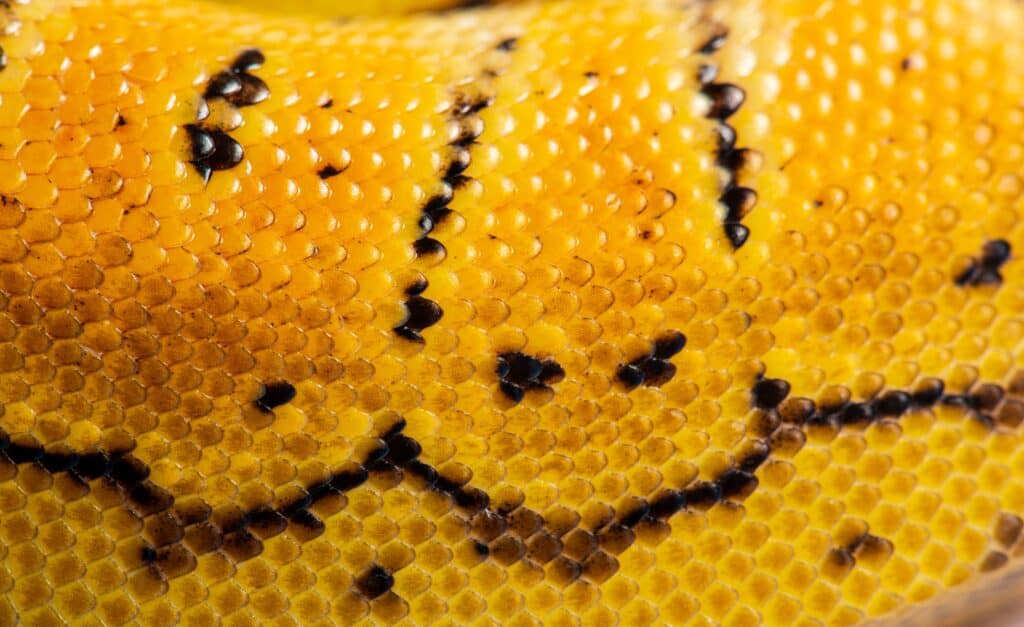Lemon Blast Ball Python
Python regius
Advertisement
Lemon Blast Ball Python Scientific Classification
- Kingdom
- Animalia
- Phylum
- Chordata
- Class
- Reptilia
- Order
- Squamata
- Family
- Pythonidae
- Genus
- Python
- Scientific Name
- Python regius
Read our Complete Guide to Classification of Animals.
Lemon Blast Ball Python Conservation Status
Lemon Blast Ball Python Facts
- Prey
- Rodents, birds, amphibians, fish
- Main Prey
- Small rodents
- Group Behavior
- Solitary
- Most Distinctive Feature
- Bright yellow body coloration and reduced brown markings
- Temperament
- Docile, curious, hardy
Lemon Blast Ball Python Physical Characteristics
- Color
- Brown
- Yellow
- White
- Gold
- Tan
- Dark Brown
- Cream
- Golden
- Light-Brown
- Skin Type
- Scales
- Lifespan
- 20 to 30 years
- Venomous
- No
- Aggression
- Low
View all of the Lemon Blast Ball Python images!
“With its extremely reduced brown markings and otherwise vivid yellow body coloration, the lemon blast ball python morph is truly one-of-a-kind.”
Lemon Blast Ball Python Summary
Originally developed in 2003 by Brian Barczyk with BHB Enterprises, the lemon blast ball python is one of the most vibrant and visually unique morphs on the market today.
The majority of the snake’s body coloration can range from a warm golden shade to an almost neon electric yellow. Meanwhile, its entire body has thin, webbing-like brown markings rather than the large brown splotches typical of the average wild-type ball python. The snake’s head is typically light brown with a pale spot in the center accented by brown and yellow eye stripes.
This incredible morph is the result of combining the very popular pastel and pinstripe morphs via selective breeding. It retains the reduced patterning of the pinstripe morph as well as the pastel morph’s brighter, bolder coloration. High blushing is common, particularly atop the snake’s head and the sides of the body.
4 Amazing Lemon Blast Ball Python Facts!
- The lemon blast morph is a designer morph that cannot naturally exist in the wild. It possesses both the pastel and pinstripe traits.
- In contrast to their boldly colored bodies, lemon blast ball pythons typically have solid white bellies with little to no patterning.
- Lemon blast ball pythons commonly have greenish or golden eyes.
- Developed way back in 2003, the lemon blast morph is one of the oldest designer ball python morphs.
Where to Find Lemon Blast Ball Pythons
In the wild, ball pythons are native to central and western Africa, mainly in the Sub-Saharan region. Hardy and adaptable, these snakes are able to live comfortably in a wide range of habitats. However, they are best suited to grasslands, savannas, and forested habitats.
Because most designer ball python morphs like the lemon blast variety involve the careful combining of multiple genetic traits, they cannot be born naturally outside of a captive breeding setting. While most base morphs can technically exist in the wild, legitimate, documented occurrences of this happening are incredibly rare.
Today, various reptile breeders have developed their own lines of lemon blast ball pythons. Depending on who you buy your snake from, the snake’s actual coloration and patterning, and the supply and demand for that particular morph in your area, the price of a single lemon blast snake can vary from around $150 to $250.
Keep in mind that morphs with additional traits, such as the banana lemon blast or the scaleless lemon blast, can be far more costly due to the more complicated breeding process involved.
Lemon Blast Ball Python Scientific Name
All ball python morphs are members of the same species, so they all have the same scientific name: Python regius.
This taxonomic name translates to “royal python.” It refers to the widespread belief amongst historians that Egypt’s ancient royals like Queen Cleopatra herself wore live snakes, most likely baby ball pythons, around their arms and wrists as jewelry. Notably, “royal python” is an alternative common name for the species.
Population and Conservation Status
As of 2012, the IUCN Red List classifies the ball python as near-threatened. Although the species is not currently at risk of facing extinction anytime soon, it is experiencing a slight population decline within its native African habitat.
Wild ball pythons are mainly threatened by habitat loss caused in large part by the agricultural industry. In addition, hunters commonly target them for food. They also capture and sell them into the exotic pet trade, which has further reduced their numbers.
It is unknown exactly how many ball pythons actually exist in the wild or in captivity. However, the lemon blast morph in particular is quite common today among reptile hobbyists.
Appearance and Description
The lemon blast morph is by far one of the most easily identifiable ball python morphs due to its unique patterning and extremely bold coloration. Its pastel and pinstripe traits are both on full display, resulting in a mostly yellow snake with thin, webbing-like dark brown markings and a pale white or yellowish belly.
Aside from these main traits, lemon blast ball pythons have several other markings that clearly set them apart from other morphs. Typically, the top of the snake’s head is light to dark brown with a prominent pale, off-white spot in the center. On the sides of the snake’s head are bold brown and yellow eye stripes. Lots of blushing is also common, which tends to appear as faded patches along the sides of the body. All in all, the morph is a perfect combination of the pinstripe and pastel traits.
Look for these key traits if you’re trying to identify a lemon blast ball python:
- Almost entirely yellow body color with reduced brown markings that look like thin web-like lines rather than large splotches
- Blushing, or faded patches along the snake’s sides
- A pale white belly with little to no markings or patterning
- A light to dark brown head with a pale spot in the center and yellow and brown eye stripes
Evolution and History
The lemon blast morph is relatively old as far as designer morphs go. Prominent reptile breeder Brian Barczyk developed it back in 2003 with BHB Enterprises.
The base pastel and pinstripe traits that went into this morph’s creation were developed in 1997 and 2001 respectively. Notably, BHB Enterprises also created the pinstripe morph, while the breeders at New England Reptile Distributors developed the pastel morph.
Today, various reptile breeders worldwide have created their own lemon blast lines of ball pythons. The morph has also been involved in the development of various other more modern designer morphs, including the scaleless lemon blast and banana lemon blast varieties.

Lemon blast ball pythons are known for their color and thin, webbing-like dark brown markings.
©Robert Eastman/Shutterstock.com

The scales of the lemon blast ball python are a beautiful shade of yellow.
©Eric Isselee/Shutterstock.com
Lemon Blast Ball Python: How Dangerous Are They?
At just 5 to 6 feet long with a docile temperament and no fangs or venom, the ball python is without a doubt one of the least dangerous snakes in the world. It is one of the smallest members of the python family, and it mainly hunts very small prey like rats, mice, and birds.
Notably, ball pythons are constrictor snakes. Instead of incapacitating their prey with a venomous bite, they suffocate their prey with their muscular bodies. As ambush hunters, they prefer to hide and wait very quietly for a small bird, rodent, or perhaps an amphibian to cross their path before striking. Next, they will cling to the prey animal with their small but sharp teeth before quickly coiling their body around their unfortunate meal as tightly as possible. Once the prey animal has suffocated, the ball python will slowly swallow it whole.
Fortunately, ball pythons are unable to take down prey much larger than a rat or a small bird. They rarely show aggression toward humans. Instead of attacking or adopting an intimidating posture, they will typically either flee or defensively curl up in a ball when upset, startled, or angry.
In the rare case that a ball python does bite you, you are unlikely to need much medical intervention. Carefully place the snake into its enclosure and ensure it is not seriously injured. Since ball pythons have small and fragile teeth, the resulting bite wound will likely require little more than warm water, soap, and perhaps a bandage to prevent infection.
Behavior and Humans
The ball python originally became popular in the exotic pet trade in the mid-1990s. Its small size, curious and friendly personality, and hardiness made it an instant favorite amongst expert and beginner reptile hobbyists alike.
Ball pythons can live quite comfortably in enclosures as small as 50 to 60 gallons and have reasonable, straightforward care requirements. They also tolerate handling remarkably well compared to other popular pet reptiles.
By the early 2000s, many reptile breeders worldwide began developing their own unique morphs and selling captive-bred ball pythons. The lemon blast morph is among the first true designer morphs to be bred and sold on a large scale. It remains a popular choice today thanks largely to its stunning color and patterning and relatively inexpensive price point.
Related Animals:
View all 98 animals that start with LLemon Blast Ball Python FAQs (Frequently Asked Questions)
Are lemon blast ball pythons venomous?
All ball python morphs are non-venomous since they all belong to the same species. They take down their prey via ambush and constriction rather than envenomation.
How do lemon blast ball pythons hunt?
As ambush hunters, ball pythons will typically wait very quietly, usually while camouflaged, for a small prey animal like a mouse or a bird to cross their path. At the right moment, they will strike, clinging to the animal with their thin, sharp teeth. They will then wrap their body as tightly as possible around the animal to suffocate it before swallowing it whole.
Where do lemon blast ball pythons live?
Wild ball pythons live in western and central Africa. They tolerate a wide range of habitats but prefer savannas, grasslands, and forests. While some basic morphs can technically exist in the wild in very rare instances, designer morphs like the lemon blast variety must be bred in very specific conditions.
What do lemon blast ball pythons eat?
Ball pythons mostly feed on small rodents like mice and rats. In addition, they often hunt small birds, amphibians, and occasionally even fish. In general, reptile owners feed their ball pythons captive-bred feeder rodents. These are often frozen and designed to be thawed prior to feeding.
Are lemon blast ball pythons rare?
Lemon blast ball pythons are technically extremely rare in the wild, as they cannot actually occur naturally. In captivity, though, they are fairly accessible, as the morph has existed since 2003. Since then, many breeders have created their own lines of lemon blast ball pythons.
Are lemon blast ball pythons aggressive?
Ball pythons are among the least aggressive snake species in the world. In general, they are timid yet curious and tolerate being handled well. All ball python morphs generally share the same gentle and tame temperament.
How much do lemon blast ball pythons cost?
The average price of a lemon blast ball python is roughly $150 to $250. However, this price can vary based on where you purchase the snake, its exact coloration and patterning, the current supply and demand for the morph, and whether it possesses any additional traits.
Thank you for reading! Have some feedback for us? Contact the AZ Animals editorial team.
Sources
- Animal Diversity, Available here: https://animaldiversity.org/accounts/Python_regius/
- IUCN Red List (1970) iucnredlist.org/species/177562/15340592
- NW Reptiles (1970) nwreptiles.com/lemon-blast/
- World of Ball Pythons (1970) worldofballpythons.com/morphs/lemon-blast/

















